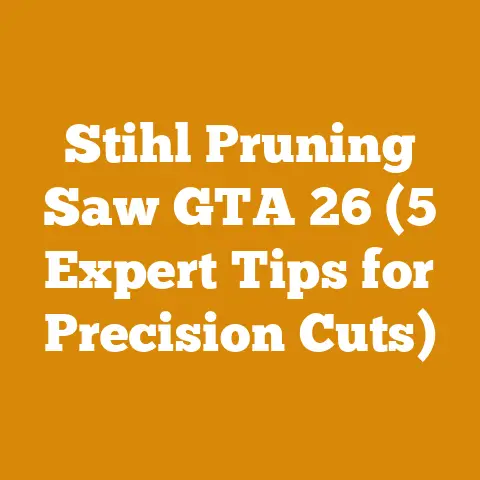Can You Trim Arborvitae to Keep Them Small? (Pro Pruning Tips)
Do you ever find yourself craving a perfectly manicured landscape, where every shrub and tree stands precisely at the height you envision? I certainly do. Let’s dive into the pro pruning tips that will help you achieve your desired arborvitae size and shape while maintaining their health and beauty.
Understanding Arborvitae and Their Growth Habits
Before I grab my pruning shears, I always make sure I understand the subject of my pruning. Arborvitae (Thuja spp.) are popular evergreen conifers known for their dense foliage and pyramidal shape. They come in various sizes, from dwarf varieties perfect for small gardens to towering giants that can create impressive privacy screens. Understanding their natural growth habit is crucial for successful pruning.
- Growth Rate: Arborvitae generally grow at a moderate rate, adding about 1-3 feet per year, depending on the variety and growing conditions.
- Natural Shape: Most arborvitae cultivars naturally grow into a pyramidal or conical shape. This is important to keep in mind when pruning, as you want to maintain their natural form.
- Foliage: Arborvitae have scale-like foliage that is typically green but can also be golden or bluish-green. New growth is often a brighter green, which can be visually appealing.
- Regrowth: Arborvitae can regenerate new growth from green foliage but not from old, brown wood. This is a critical point to remember when pruning, as cutting back too far can result in unsightly bare patches.
The Importance of Proper Pruning
Pruning isn’t just about aesthetics; it’s vital for the health and longevity of your arborvitae. Here’s why:
- Controlling Size and Shape: Regular pruning helps maintain the desired size and shape of your arborvitae, preventing them from outgrowing their space or becoming misshapen.
- Improving Air Circulation: Pruning can thin out dense foliage, improving air circulation within the tree. This reduces the risk of fungal diseases and other problems.
- Removing Dead or Damaged Branches: Dead or damaged branches can harbor pests and diseases. The best time to prune arborvitae is during the dormant season, late winter or early spring, before new growth begins. This allows the tree to recover quickly and put its energy into new growth.
- Dormant Season (Late Winter/Early Spring): This is the ideal time for more significant pruning, such as reducing the height or width of the tree.
- Late Spring/Early Summer: You can also do light pruning in late spring or early summer to maintain the shape and remove any stray growth.
- Avoid Late Summer/Fall: Avoid pruning in late summer or fall, as new growth may not have time to harden off before winter, making it susceptible to cold damage.
Tools of the Trade: Essential Pruning Equipment
Having the right tools makes pruning easier, safer, and more effective. Here’s my go-to list:
- Hand Pruners: Ideal for small branches (up to 1/2 inch in diameter). I prefer bypass pruners, as they make clean cuts without crushing the stems. My favorite brand is Felco. I’ve been using them for years, and they’re worth the investment.
- Loppers: For larger branches (up to 1 1/2 inches in diameter). Loppers provide more leverage than hand pruners, making it easier to cut thicker branches. Again, bypass loppers are the way to go.
- Pruning Saw: For branches larger than 1 1/2 inches in diameter. A pruning saw has a narrow blade that can easily cut through thick branches. I use a folding pruning saw for portability.
- Hedge Trimmer: For shearing or shaping hedges. I use a gas-powered hedge trimmer for larger jobs and a battery-powered one for smaller, more precise work.
- Ladder: For reaching high branches. Choose a sturdy ladder that is the appropriate height for the job. Always follow safety guidelines when using a ladder.
- Gloves: To protect your hands from scratches and thorns.
- Eye Protection: To protect your eyes from flying debris.
- Sharpener: To keep your tools sharp. Sharp tools make cleaner cuts and are safer to use. I use a sharpening stone to keep my pruners and saws in top condition.
Tool Specifications Example:
- Hand Pruners: Felco F-8 (Bypass Pruners), Cutting Capacity: 1 inch, Weight: 8.5 oz.
- Loppers: Fiskars PowerGear2 Lopper (Bypass Loppers), Cutting Capacity: 2 inches, Length: 25 inches.
- Pruning Saw: Corona RazorTOOTH Folding Pruning Saw, Blade Length: 10 inches.
Step-by-Step Guide to Pruning Arborvitae
Now, let’s get down to the nitty-gritty. Here’s a step-by-step guide to pruning your arborvitae to keep them small and healthy.
Step 1: Assess the Tree
Before you start cutting, take a good look at the tree. Identify any dead, damaged, or diseased branches. Also, consider the overall shape and size of the tree and decide what you want to achieve with pruning.
- Check for Deadwood: Look for branches that are brown, brittle, or have no foliage.
- Inspect for Damage: Look for broken branches, cracks, or signs of insect infestation or disease.
- Evaluate Shape: Determine if the tree is symmetrical or if it needs shaping.
- Consider Size: Decide how much you want to reduce the height or width of the tree.
Step 2: Remove Dead, Damaged, or Diseased Branches
Using your hand pruners, loppers, or pruning saw, remove any dead, damaged, or diseased branches. Cut back to a healthy bud or branch. Make sure to make clean cuts to promote healing.
- Cut at a 45-Degree Angle: This encourages water to run off the cut surface, preventing rot.
- Cut Close to the Branch Collar: The branch collar is the swollen area where the branch joins the trunk. Cutting too close to the trunk can damage the tree.
- Dispose of Diseased Branches Properly: To prevent the spread of disease, burn or dispose of diseased branches in a sealed bag.
Step 3: Thin Out Dense Foliage
If the foliage is too dense, thin it out to improve air circulation. Remove some of the interior branches to allow more light and air to penetrate the tree. This is especially important for preventing fungal diseases.
- Remove Crossing Branches: Branches that cross each other can rub and cause damage.
- Remove Suckers: Suckers are small shoots that grow from the base of the tree.
- Remove Water Sprouts: Water sprouts are fast-growing shoots that grow vertically from the branches.
- Aim for Even Spacing: Remove branches to create even spacing throughout the tree.
Step 4: Reduce Height and Width (If Necessary)
If you want to reduce the height or width of the tree, use your pruning saw or loppers to cut back the leader (the main vertical stem) or side branches. Make sure to cut back to a lateral branch or bud that is pointing in the direction you want the new growth to go.
- Cut at an Angle: Cut the leader at a 45-degree angle to encourage new growth.
- Cut Back to a Lateral Branch: This will help maintain the natural shape of the tree.
- Don’t Remove Too Much at Once: It’s better to prune lightly over several years than to remove too much at once. Removing more than 1/3 of the tree’s foliage in a single year can stress the tree.
Step 5: Shape the Tree
Use your hand pruners or hedge trimmer to shape the tree to your desired form. Keep in mind the natural pyramidal or conical shape of arborvitae. Avoid shearing the tree into unnatural shapes, as this can damage the foliage and make it more susceptible to disease.
- Follow the Natural Shape: Prune to enhance the natural shape of the tree.
- Avoid Shearing: Shearing can create a dense outer layer of foliage that blocks light and air from reaching the interior of the tree.
- Make Gradual Adjustments: Prune lightly and frequently to maintain the desired shape.
Step 6: Clean Up and Dispose of Debris
Once you’re finished pruning, clean up all the debris from around the tree. This will help prevent the spread of disease and keep your yard looking tidy.
- Rake Up Clippings: Use a rake to gather up all the clippings from around the tree.
- Dispose of Debris Properly: Compost the clippings or dispose of them in a yard waste bag.
- Clean Your Tools: Clean your pruning tools with rubbing alcohol to prevent the spread of disease.
Specific Pruning Techniques for Different Arborvitae Varieties
Different arborvitae varieties may require slightly different pruning techniques. Here are some tips for pruning popular varieties:
- Emerald Green Arborvitae: This variety is known for its narrow, columnar shape. Prune to maintain its shape and remove any stray branches. Avoid topping the tree, as this can ruin its form.
- Green Giant Arborvitae: This variety is a fast-growing, large tree. Prune to control its size and shape. You can also use it to create a privacy screen. I’ve seen some amazing privacy hedges created with Green Giant.
- Techny Arborvitae: This variety is a hardy, adaptable tree. Prune to maintain its shape and remove any dead or damaged branches.
- Little Giant Arborvitae: This variety is a dwarf, globe-shaped tree. Prune to maintain its shape and remove any stray branches.
Common Pruning Mistakes to Avoid
Even experienced gardeners can make pruning mistakes. Here are some common mistakes to avoid:
- Pruning at the Wrong Time: Pruning in late summer or fall can damage the tree.
- Removing Too Much Foliage: Removing more than 1/3 of the tree’s foliage in a single year can stress the tree.
- Shearing the Tree: Shearing can create a dense outer layer of foliage that blocks light and air from reaching the interior of the tree.
- Topping the Tree: Topping the tree can ruin its shape and make it more susceptible to disease.
- Using Dull Tools: Dull tools can crush the stems and make it harder for the tree to heal.
- Not Cleaning Your Tools: Not cleaning your tools can spread disease from one tree to another.
Case Study: Pruning an Overgrown Emerald Green Arborvitae
I once had a client who had an Emerald Green arborvitae that had become severely overgrown. It was blocking the sunlight from their windows and looked quite unsightly. Here’s how I tackled the project:
- Assessment: I started by assessing the tree. It was about 15 feet tall and 5 feet wide, much larger than it should have been. The foliage was dense, and there were several dead branches.
- Deadwood Removal: I began by removing all the dead branches using my hand pruners and loppers.
- Thinning: I then thinned out the dense foliage by removing some of the interior branches. This improved air circulation and allowed more light to reach the interior of the tree.
- Height Reduction: To reduce the height of the tree, I cut back the leader by about 3 feet. I made sure to cut at a 45-degree angle and back to a lateral branch.
- Width Reduction: To reduce the width of the tree, I pruned back the side branches. I made sure to maintain the tree’s natural columnar shape.
- Shaping: Finally, I shaped the tree to create a more balanced and aesthetically pleasing form.
- Clean Up: I cleaned up all the debris from around the tree and disposed of it properly.
The client was thrilled with the results. The tree was now a more manageable size, and it looked much healthier and more attractive.
Strategic Advantages of Proper Arborvitae Pruning
Beyond the immediate aesthetic benefits, proper pruning offers several strategic advantages:
- Increased Property Value: Well-maintained landscaping, including properly pruned arborvitae, can significantly increase the value of your property.
- Reduced Maintenance Costs: Regular pruning can prevent problems from developing, reducing the need for more costly interventions in the future.
- Improved Plant Health: Healthy plants are less susceptible to pests and diseases, reducing the need for pesticides and other treatments.
- Enhanced Curb Appeal: A well-groomed landscape creates a positive first impression and enhances the overall curb appeal of your home.
Financial Considerations
Pruning arborvitae yourself can save you money compared to hiring a professional. However, it’s important to factor in the cost of tools and equipment. Here’s a breakdown of potential costs:
- Tools: Hand pruners ($30-$50), loppers ($40-$70), pruning saw ($20-$40), hedge trimmer ($100-$300).
- Safety Gear: Gloves ($10-$20), eye protection ($5-$10).
- Professional Pruning: Hiring a professional arborist can cost anywhere from $50 to $200 per hour, depending on the size and complexity of the job.
Cost-Benefit Analysis Example:
- DIY Pruning: Initial investment in tools and equipment may be higher, but you can use them for multiple pruning projects.
- Professional Pruning: Higher upfront cost, but you benefit from the expertise of a professional and avoid the need to purchase tools.
Safety First: Pruning Safety Guidelines
Safety should always be your top priority when pruning. Here are some essential safety guidelines:
- Wear Appropriate Safety Gear: Always wear gloves and eye protection to protect yourself from scratches and flying debris.
- Use a Sturdy Ladder: If you need to reach high branches, use a sturdy ladder that is the appropriate height for the job. Make sure the ladder is on a stable surface and that someone is holding it for you.
- Be Aware of Your Surroundings: Watch out for power lines, fences, and other obstacles.
- Use Sharp Tools: Sharp tools are safer to use than dull tools. Dull tools require more force, which can lead to accidents.
- Take Breaks: Pruning can be physically demanding. Take breaks to avoid fatigue.
- Know Your Limits: If you’re not comfortable pruning a tree yourself, hire a professional.
Next Steps: Putting Your Pruning Skills to Work
Now that you have a solid understanding of how to prune arborvitae, it’s time to put your skills to work. Start by assessing your arborvitae and identifying any areas that need pruning. Gather your tools and safety gear and follow the step-by-step guide outlined above. Remember to prune lightly and frequently to maintain the desired size and shape of your trees.
Conclusion: The Art and Science of Arborvitae Pruning
Pruning arborvitae is both an art and a science. It requires a combination of knowledge, skill, and patience. By understanding the growth habits of arborvitae, using the right tools, and following the proper techniques, you can keep your arborvitae small, healthy, and beautiful for years to come. And remember, don’t be afraid to experiment and learn from your mistakes. Every pruning project is a learning opportunity. So, grab your pruners and get to work! Your arborvitae will thank you for it.






